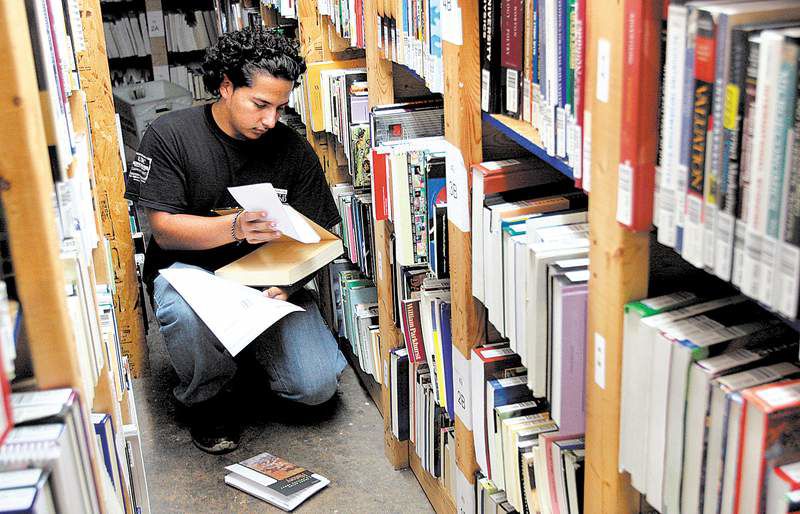Used-textbook trade only fuels high prices
Published 5:00 am Thursday, August 21, 2008

- Jose Centeno, 19, of Hyattsville, Md., fills orders at Bookholders.com of College Park, Md., which sells used textbooks. The rising cost of college texts has driven Congress and about 30 states to attempt to curtail prices and controversial publishing practices through legislation.
WASHINGTON — The rising cost of college textbooks has driven Congress and nearly three dozen states to attempt to curtail prices and controversial publishing practices through legislation. But as the fall semester begins, students are unlikely to see much relief.
Estimates of how much students spend on textbooks range from $700 to $1,100 annually, and the market for new books is estimated at $3.6 billion this year. Between 1986 and 2004, the price of textbooks nearly tripled, rising an average of 6 percent a year while inflation rose 3 percent, according to a 2005 report by the Government Accountability Office.
Trending
“It’s really hard just paying for tuition alone,” said Annaiis Wilkinson, 19 and a student at Trinity University in Washington who spends about $500 a semester on books. “It really sets people back.”
Last month, Congress passed legislation forcing publishers to release more information about their prices. It also requires them to sell a textbook separately rather than packaged with a CD or workbook that makes for a more expensive purchase. However, the provisions do not take effect until 2010.
Meanwhile, although 34 states have introduced similar proposals during the past three years, only six states have approved them. Virginia passed its Textbook Fairness Act in 2005, but any impact of the new laws at the cash register remains to be seen.
“The principal goal of the legislation, which we are totally supportive of, is transparency,” said Bruce Hildebrand, executive director of higher education for the Association of American Publishers, a trade group. “It’s what the industry already does.”
A vicious circle
Costs for new textbooks have risen as publishers have tried to fight off an expanding trade in used books. The market for used textbooks began exploding with the growth of the Internet as students from across the country connected to buy and sell their books, cutting into the sales of new books and eating away at publishers’ market share.
Trending
Publishers began making new books more attractive by packaging them with workbooks and CDs — but with a higher total price. They are making them indispensable by equipping them with one-use codes needed for access to additional course material online. They are creating custom editions for specific professors or universities, limiting the resale market for the books.
At the University of Maryland, for example, an algebra text published by a division of textbook heavyweight Pearson comes with a solutions manual and sells new for $138. Used bookstore Bookholders.com, based in College Park, Md., sells the components separately: the textbook for $80 and the solutions manual for 81 cents.
A microeconomics textbook put out by a division of Cengage Learning comes with an online activation card and costs $99. Buying a new activation card for a used book — if you can find one — is $79, nearly the same as the new book.
“People don’t buy textbooks for the rest of their lives,” said John Verde, founder of Bookholders .com. “The difference between used and new is very little.”
The used market
Sales of used textbooks last year grew 15 percent to $2 billion, with double-digit growth expected through 2011, according to Simba Information, a market research group. Meanwhile, sales of new textbooks have grown by 4 percent to 5 percent annually, with the market this year expected to reach $3.6 billion. Simba ranks eight major publishers, with the two largest companies, Pearson and Cengage, controlling roughly half of the market last year.
“What typically drives the growth in new textbooks is the fact that they’re new,” Simba analyst Kathy Mickey said. “They’re given a semester or a year before they’re really impacted by used textbooks.”
Publishers dispute the notion that their textbooks are overpriced. Last fall, there were 216 introductory psychology titles competing with each other on bookshelves at prices ranging at retail from $23 to $120, Hildebrand said. Developing a new textbook is a costly venture with uncertain returns, and that risk is built into the price.
In addition, Hildebrand said, publishers are facing increased demands from students and teachers. Supplemental materials have become increasingly popular as students require more remediation and universities turn to part-time faculty and graduate students to teach courses.
Creative workarounds
Wilkinson and her friends have invented their own methods for lowering the cost of their books. They’ve borrowed copies from the school library or photocopied pages from a friend’s book. They’ve pooled their cash to buy one book, even though that makes it tough for everyone to study during exams. One took out another loan to cover textbooks.
“Any which way you look at it, you’re still spending obscene amounts of money for a couple of books you have for three months,” she said.
Other students have turned to illicit measures: downloading pirated copies of textbooks online. One site, Textbook Torrents, temporarily shut down this summer after complaints from publishers but has re-emerged with 80,000 registered users and 25,000 sessions running at any given time, according to the site administrator, who identified himself by his screen name of Geekman. Titles include full .pdf files of books ranging from Marketing Across Cultures to Fundamentals of Thermodynamics, Sixth Edition.
A coalition of student public interest research groups, or PIRGs, and student government associations have been circulating a petition among college professors that calls for more affordable textbooks and advocates free digital textbooks. More than 1,400 professors at 300 colleges have signed the petition.
Publishers say they are making efforts to reduce costs. Five of the leading textbook publishers — including Pearson, Cengage Learning and McGraw Hill — recently launched an online marketplace for digital textbooks entitled CourseSmart. Students saved an average of $54 per e-textbook this month, according to the site.






